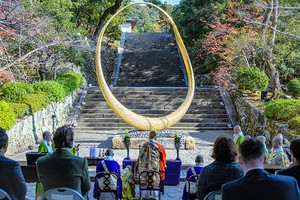THE ASAHI SHIMBUN
June 18, 2024 at 16:52 JST
Special tablet computers, smartphone apps and robots are increasingly being used at restaurants to promote convenience, but visually impaired people say such innovations have created another barrier in their dining experiences.
Disabled people say they often need human-to-human interactions to get by, but the self-ordering systems and other automated features have slashed workforces at eateries.
Kanji Yamashiro, 68, who heads the National Council of Japan for the Visually Impaired, a general incorporated association, explained the problems he encountered when he went to a beef bowl chain restaurant in Tokyo in February.
Customers at the restaurant order items from a ticket machine, choose their seats, and pick up the items at the counter when the food is ready.
There were no staff members near the entrance of the restaurant, and Yamashiro, who was born with severely low vision, could not understand the ordering system.
He managed to reach the ticket machine by gauging the voices of customers and listening for the sound of the machine.
However, he could not discern the menu and prices on the touch-screen system.
Yamashiro asked for help from a nearby customer. But he felt guilty for taking up the customer’s time, so he ordered the very first item that was read out to him.
“Before, all I had to do was sit down and I could eat there. Now I can no longer go to the restaurant by myself,” he said.
Yamashiro said the new technologies used have further limited his options for dining out.
A family restaurant in his neighborhood has installed tablet terminals at each seat and removed all call buttons to summon waitstaff.
Yamashiro said the only way to call the waitstaff now is to raise his voice to summon help to place his order.
The problems do not end there.
A robot, not a human worker, now brings the ordered items to the table.
Yamashiro said he could hear the melodic sound that the robot made, but it was difficult to tell where the machine was and even harder to receive the dishes.
Although some restaurants have a menu-readout function, it takes time to hear the entire menu, and it is difficult to know where to press to complete the order, he said.
At a Japanese-style “izakaya” pub he has frequented, the number of workers has decreased. Yamashiro said that now, when he asks a staff member to read the menu or guide him to the restroom, the request is sometimes denied.
Yamashiro said the National Council of Japan for the Visually Impaired has recently held many consultations with people who experienced similar problems.
Nobuko Fujino, 66, who lost her sight at the age of 5, said she has fewer opportunities to visit new restaurants.
“I love dining out once in a while, but I often have trouble at places, and it diminishes my desire to go out,” she lamented.
The revised law for the elimination of discrimination against persons with disabilities took effect on April 1.
Under the law, if a disabled person expresses a desire to have a social barrier removed, businesses are required to take necessary and reasonable measures to remove that barrier.
Yamashiro, however, feels that barriers are increasing not only at restaurants but also at other businesses because of their reduced payrolls.
He noted that self-service cash registers are becoming more common at supermarkets, while train stations have cut the number of manned ticket counters. Touch panels have also been introduced to check in at accommodations.
Yamashiro stressed that human interaction is necessary for the lives of disabled people.
“I think we lack a perspective on people with disabilities,” he said. “I am very worried about how society is going to change.”
Recruit Co. sells self-ordering systems that customers can use on their smartphones. The company said cumulative sales in March were 2.4 times larger than the figure in the same month last year.
According to Recruit’s nationwide survey of restaurant operators conducted in March, 7 percent said they had introduced self-ordering systems, more than double the ratio three years ago.
Around 9 percent of the responding restaurants said they were considering introducing the systems.
According to another Recruit survey of customers in 2022, 70.1 percent said they want to use the dedicated terminals at their restaurant seats, far more than the 8.9 percent who preferred not to use the system.
Those in favor of the terminals cited “convenience” and “not having to bother the waitstaff every time.”
A Recruit representative said self-ordering systems, along with acrylic boards, were introduced around 2021 during the COVID-19 pandemic to let customers place orders in a “non-contact” manner.
The representative said the use of self-ordering systems will likely increase at an accelerated pace due to labor shortages and rising costs of raw materials.
Gusto, a family restaurant chain, has installed tablet terminals for ordering at each of its 1,260 locations.
A representative of Skylark Group, a company that manages Gusto, said the purpose of the self-ordering system is to improve convenience for customers and create a comfortable working environment for staff.
The representative said restaurant workers are also trained to provide support to visually impaired customers, including greeting them at the entrance, explaining the menu, taking their orders, and serving the food.
(This article was written by Emika Terashima and Akihito Ogawa.)




















A peek through the music industry’s curtain at the producers who harnessed social media to help their idols go global.
A series based on diplomatic documents declassified by Japan’s Foreign Ministry
Here is a collection of first-hand accounts by “hibakusha” atomic bomb survivors.
Cooking experts, chefs and others involved in the field of food introduce their special recipes intertwined with their paths in life.
A series about Japanese-Americans and their memories of World War II